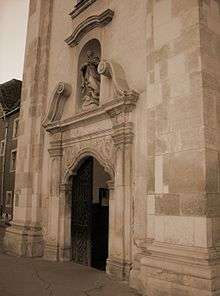Cluj-Napoca Franciscan Church
| Cluj-Napoca Franciscan Church | |
|---|---|
 Entrance to the church | |
| Basic information | |
| Location | Cluj-Napoca, Romania |
| Affiliation | Roman Catholic |
| District | Roman Catholic Archdiocese of Alba Iulia |
| Year consecrated | 1290 |
| Ecclesiastical or organizational status | Church |
| Architectural description | |
| Completed | 1290 |
The Franciscan Church is a place of worship in Cluj-Napoca, Romania. It was built between 1260 and 1290, on the site of an older Catholic church destroyed during the Tatar invasions in 1241.
History
In 1390, the Benedictine monks received the church. They extended it and built a small Gothic cloister near the church, with the help of John Hunyadi.
In 1556, the Queen of Hungary, Isabella Jagiełło moved to the cloister and lived there with her son John II Sigismund Zápolya until 1557.
The church is located on Museum Square (Piața Muzeului), previously known as the Little Square (Piața Mică) to distinguish it from the Large Square surrounding St. Michael's Church; Caroline Square (Piața Carolina or Karolina ter), after the nearby Caroline Obelisk built in honor of the 1817 visit of Caroline Augusta of Bavaria and her husband Francis II; and Dimitrov Square (Piața Dimitrov), so named in the early communist period for Georgi Dimitrov.[1][2][3][4]
Notes
- ↑ (Romanian) Piața Muzeului at the Cluj-Napoca City Hall site; accessed July 26, 2013
- ↑ (Romanian) Mănăstirea Franciscanilor at the Cluj County Cultural Office; accessed July 26, 2013
- ↑ (Romanian) Centrul vechi at the Central University Library of Cluj-Napoca site; accessed July 26, 2013
- ↑ (Romanian) "Biserica şi fosta mănăstire franciscană din Cluj", Jurnalul Național, July 26, 2007; accessed July 26, 2013
References
- (Romanian) Lukacs Jozsef - Povestea „oraşului-comoară”, Editura Biblioteca Apostrof, Cluj-Napoca, 2005
- (Romanian) Bodea Gheorghe - Clujul vechi şi nou, Cluj-Napoca, 2002
External links
- (Romanian) Biserica şi fosta mănăstire franciscană din Cluj (The Franciscan church and cloister from Cluj-Napoca)
- (Hungarian) Old pictures of the church and cloister

Coordinates: 46°46′18″N 23°35′16″E / 46.77167°N 23.58778°E